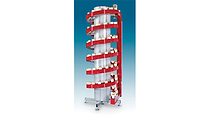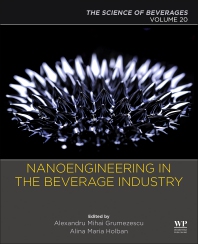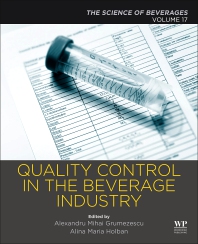More beverage-makers integrating robots in operations
Cost reductions, long-term ROI support increase in sales

Beverage-makers should consider an overall life cycle assessment when deciding whether to invest in robotics technology, FANUC America’s Dick Motley advises. (Image courtesy of FANUC America Corp.)

BluePrint Automation integrated robotics technology into its CPIII Wrap-Around Casepacker that automatically erects, loads and closes wrap-around cases, trays, tray-lid combinations and regular slotted cases. (Image courtesy of BluePrint Automation)


Hollywood has shown both the endearing side of robots, such as in Walt Disney’s “Wall-E,” and the more feared versions from the “Terminator” franchise. Although movies and TV shows have tried to enlist strong emotions from viewers when it comes to pop-culture robots, in reality, robots are simply a solution to efficient warehouse operations.
According to the Robotic Industries Association (RIA), 14,135 robots were ordered from North American robotics companies in the first half of 2014, an increase of 30 percent in units compared with that same timeframe in 2013. The second quarter accounted for the majority of sales with 8,197 units sold to North American customers. Since 2010, robotics sales in North America have increased an average of 26 percent each year, the RIA adds.
The automotive-related industries had the strongest growth with 97 percent more orders compared with the previous year; however, the semiconductors, life sciences, and food and consumer goods industries increased robotics purchases by 22 percent versus the first half of 2013, according to the RIA.
Robot manufacturers as well as their system integrator partners also have taken notice of the increase in sales. They also note that although the beverage industry might lag some other industries when it comes to adoption, efforts are being made to make integration possible for this audience.
Integrating with beverages
Dick Motley, regional director for FANUC America Corp.’s Southeast region, says the robotics market within beverages is definitely increasing, and he credits that to a number of reasons, including documented success from early and even second-round adopters.
Working with its integrator network within the beverage industry, the Rochester Hills, Mich.-based company has assisted in the development of standard and semi-standard robots that feature a mature history and proven track record, Motley notes. “I think that’s helping with the acceptance, and people are more comfortable taking advantage of some of the characteristics of the robotics system,” he says.
Brian Huse, marketing specialist for Ann Arbor, Mich.-based Güdel Inc., the U.S. subsidiary of Güdel Group, adds that the beverage industry was one of the rising industries with integrating robotics prior to the economic recession of 2008. Because of advancements made to robots, beverage facilities now have an increasing number of opportunities to integrate them.
“Now, robots are faster, slimmer and use less space than they did even just 10 years ago, which is vital in the cramped confines of many facilities,” Huse says. “Beverage-makers use robots for handling everything from drink bags to mixed pallets, and they are almost always squeezed for space.”
Bill Leber, director of business development for Newport News, Va.-based Swisslog Logistics Inc., a division of Swisslog Holding AG, says that layer picking with robots offers beverage-makers the ability to increase productivity and accuracy as well as reduce damage to products. “You could do all this stuff manually, but that’s what you’re going to run into, so you get efficiency,” he says. “[Robots] are doing what you used to have to hire people for doing, and you have some long-term costs there with people constantly handling heavy things.”
Another reason more beverage manufacturers might be looking to add robots to their facilities is that the cost of these systems is becoming more affordable. “The cost is coming down, and performance is going up,” FANUC America’s Motley explains.
Calculating the benefits
Although suppliers note that robots and the systems they support are becoming more affordable, some beverage-makers might still express concerns when comparing the automated systems with the short-term costs of conventional systems; however, when looking at the long-term benefits, integration of robotics can be more affordable than one might think, experts note.
Motley encourages brand owners to employ an overall life cycle assessment when calculating their return on investment (ROI). Among those assessments are accounting for changeover parts and lost time for maintenance. “When looking at ROI, make sure to turn over all the rocks where the real savings might be,” he says.
Matt Wicks, vice president of product development for manufacturing systems with Intelligrated, Mason, Ohio, echoes similar thoughts. “Customers must quantify their current costs and accurately compare them with the capital investment of an automated robotic solution,” he says. “Many factors such as direct labor costs, actual productivity and labor availability are compared with equipment reliability, system effective throughput, and of course, the cost of the equipment.”
Güdel’s Huse adds that the ROI from adding robotics to one’s operations can add up when it comes to worker safety. “Robot makers provide more than another piece of automation, and the return on investment covers more than increased throughput,” he says. “One of the benefits is a safer workplace. People can focus on intellectual exercises that improve the business and avoid injury-prone jobs. This reduces costs not usually attributed to standard automation.”
Robbie Quinlin, marketing manager of BluePrint Automation (BPA), Colonial Heights, Va., adds that ROI should be calculated not just on cost savings but on quality improvements. BPA offers its CPIII Wrap-Around Casepacker that automatically erects, loads and closes wrap-around cases, trays, tray-lid combinations and regular slotted cases. The system is ideal for bottles, pouches and cartons in the food and beverage industries and offers tool-free, automatic changeovers, he adds.
In addition to the long-term ROI benefits, robotics systems can help streamline supply chain processes, experts note. Intelligrated’s Wicks notes that flexibility is a key component when considering integration. “The ability to reconfigure the solution within certain bounds offers end-users the ability to change their products/patterns, etc., without requiring physical changes,” he says.
For palletizing, Güdel’s Huse once again notes the importance of safety for warehouse workers. “When a beverage-maker adds robots to its palletizing line, they are protecting workers and the company from injuries and the burden of missed work and downtime,” he says. “At the same time, throughput goes up, and production is more dependable. There are heavy loads at the end of the line that are awkward to lift and move.”
The company offers its Trackmotion TMO family of overhead robot tracks built with linear motion components from Güdel to assist with these challenges. “A robot on Trackmotion or a gantry robot is like a super robot that can reach more product and do more work,” Huse says. “This allows a person, whether running the robot or in charge of the line, to focus on daily operations and problem solving.”
Although Trackmotion or gantry robots might be considered disruptive to operations because of the engineering required to expand horizons and add vertical motion, a horizontal axis allows for more reach and expands cycle time, Huse adds.
FANUC America’s Motley also notes that robotics systems can be good for supporting lightweighting practices. Recalling a beverage client who had allocated a lot of capital and time to lightweight the containers for its products, the client encountered some challenges with its non-carbonated beverages, he says. Because the products utilized shrinkwrap for their secondary packaging, the packages were more susceptible to product damage when they went through a traditional palletizer, Motley explains. Engaging a robotic palletizer allowed for gentle handling of the products, thereby reducing damage, he adds.
But no matter what a beverage-maker or distributor’s motivation is for employing a robotics system, Motley says one of the most important factors they should consider is ownership. It is important for leaders to convey the proper messages to employees throughout the varying levels in the company, he notes. It also is important that every shift have one person on site that views it as their personal responsibility to ensure the system is running properly, Motley adds.
“A lot of little elements [go into] building that ownership, with the end goal of having the people on the plant floor comfortable, knowledgeable and enthusiastic about incorporating the robots into their process to keep it running,” he says.
Looking for a reprint of this article?
From high-res PDFs to custom plaques, order your copy today!












